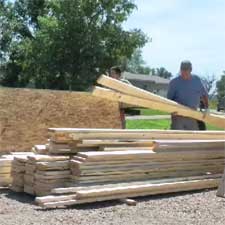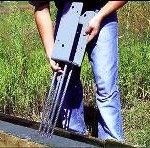¼” EE
In my exploration of lumber grade stamps, 1/4″ EE was one which I was familiar with, but had no idea what the history was behind it.
When I remodeled my 1909 home 24 years ago – it was for the most part down to the bare studs and floor joists. The lumber, having obviously been milled in 1909 or earlier, was all full sawn (the 2x4s were actually two inches by four inches) and all had square edges. As in totally square edges, not just free of wane.
According to the Western Wood Products Association (www.wwpa.org):

Framing lumber in 2″ thickness is typically produced with a 1/8″ eased edge. However, some mills produce lumber with a 1/4″ eased edge to assist in handling. These products are identified on the grademark as “1/4″ EE.”
Me, being the curious sort, wanted to know more – so I spent way too much time researching trying to find out the history of eased edge lumber. So far, it wasn’t going well.
I did find out lumber of less than four inches in thickness is usually made with eased edges. My own experience with having worked with lumber as a builder, prefabricated wood truss manufacturer and lumber yard owner confirms this. I can’t say I’ve ever seen a 2x anything with squared edges from a lumber mill.
An exception would be lumber which has been re-manufactured. An example of this would be when a low grade wide piece of lumber (say 2×12) is split lengthwise into two smaller dimensions, one of which could meet the quality specifications of a higher grade (say a 2×4 and a 2×8). Re-manufactured lumber will often have a square edge on the side which has been split.
I did find some suppositions floating around on the ‘net about eased edges. One of the most prevalent is to help reduce the incidence of slivers. I have to say, I’ve acquired far more slivers from timbers with square edges, than from smaller dimension lumber with curved edges.
One interesting theory, which I could buy into, would be because drywall installs better over the rounded corners in cases where studs twist a little and push a corner out slightly.
A second theory is it could be a “knife-check” for the blades which are used to plane lumber to S4S (surfaced four sides). My example is when the finished product starts to show square edges, it is time for new knives to be installed in the planer.
This column has thousands upon thousands of loyal readers. I am hopeful one or more of you knows more about the history and reasoning behind eased edges and will add your comments.










An owner of a local hardwood mill revealed that he made almost as much on the chips and dust as many dimensions of lumber. The rounded edge is less likely to initiate and propagate a split. So I believe that it is because mills get a “two fer” better machine grade and tons of chips to sell. We get a weaker connection.
Framing lumber has rounded edges to cut down on fire risk. The early automobile factories in Detroit all used rounded corners
on support columns as well for this reason.
Sharp edges do splinter easily, they leave thin pieces of wood which dry very quickly and easily ignite.